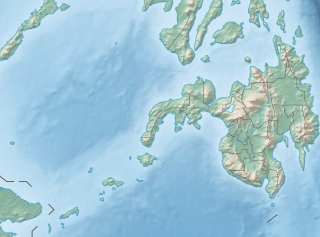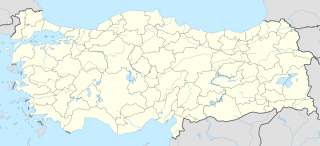
The Karakaya Dam is one of the 21 dams of the Southeastern Anatolia Project of Turkey, built on the Euphrates River and completed in 1987. The hydroelectric dam generates power with six units of 300 MW, totalling the installed capacity to 1,800 MW.

The Murat River, also called Eastern Euphrates, is a major source of the Euphrates River. The Ancient Greeks and Romans used to call the river Arsanias. It originates near Mount Ararat north of Lake Van, in Eastern Turkey, and flows westward for 722 km (449 mi) through mountainous area. Before the construction of the Keban Dam, the Murat River joined the Karasu River or Western Euphrates 10 km (6.2 mi) north of the dam site and 13 km (8.1 mi) north of the town of Keban.

The Almus Dam is an earthen embankment dam that is near the town of Almus and is located on the River Yesilirmak which runs into the Black Sea. The main purposes of the dam is irrigation, flood control and hydroelectricity. The hydroelectric power plant at the dam has a capacity of 27 megawatts. The dam contains 3,405,000 m3 (120,200,000 cu ft) of material and irrigates an area of 21,350 hectares. The dam's spillway is capable of discharging a maximum 2,800 m3/s (98,881 cu ft/s) and its bottom outlet a maximum of 50 m3/s (1,766 cu ft/s).

The Longyangxia Dam is a concrete arch-gravity dam at the entrance of the Longyangxia canyon on the Yellow River in Gonghe County, Qinghai Province, China. The dam is 178 metres (584 ft) tall and was built for the purposes of hydroelectric power generation, irrigation, ice control and flood control. The dam supports a 1,280 MW power station with 4 x 320 MW generators that can operate at a maximum capacity of 1400 MW. Controlling ice, the dam controls downstream releases to reservoirs lower in the river, allowing them to generate more power instead of mitigating ice. Water in the dam's 24.7 billion m3 reservoir provides irrigation water for up to 1,000,000 hectares of land.

Stave Falls Dam is a dual-dam power complex on the Stave River in Stave Falls, British Columbia, Canada. The dam was completed in 1912 for the primary purpose of hydroelectric power production. To increase the capacity of Stave Lake, the dam was raised in 1925 and the Blind Slough Dam constructed in an adjacent watercourse 500 m (1,600 ft) to the north, which was the site of the eponymous Stave Falls. In 2000, the dam's powerhouse was replaced after a four-year upgrade. The powerhouse was once British Columbia's largest hydroelectric power source and is a National Historic Site of Canada.

The Shin-Takasegawa Pumped Storage Station (新高瀬川発電所) uses the Takase River to operate a pumped storage hydroelectric scheme about 12 kilometres (7.5 mi) west of Ōmachi in Nagano Prefecture, Japan. Part of the system is within Chūbu-Sangaku National Park.

The Pulangi IV Hydroelectric Power Plant, also known as the Pulangi Dam, is located on the Pulangi River near Maramag in Bukidnon province on the island of Mindanao in the Philippines. It uses two reservoirs, produced by damming the Pulangi River, to supply water to a run-of-the-river hydroelectric power plant; the power plant is capable of generating 255 megawatts (342,000 hp) of power. Construction began in 1982; the first two generators became operational in December 1985, with the last generator being commissioned in 1986.

The Grand'Maison Dam is an embankment dam on L'Eau d'Olle, a tributary of the Romanche River. It is located in Vaujany of Isère within the French Alps. The primary purpose of the dam is to serve as the upper reservoir for a pumped-storage hydroelectric scheme where Lac du Verney located lower in the valley is the lower reservoir. The dam was constructed between 1978 and 1985 with its power station being commissioned in 1987. With an installed capacity of 1,800 MW, it is the largest hydroelectric power station in France.

The Çetin Dam is a rock-fill dam with an asphalt-concrete core, currently being constructed on the Botan River in Siirt Province, Turkey. The dam will be located directly downstream of the Botan and Büyük River confluence and have a height of 145 m (476 ft). The primary purpose of the dam is hydroelectric power generation. The dam's power plant will house three 135 MW Francis turbine-generators. Also part of the Çetin project is a smaller dam 6 km (4 mi) downstream with 45 m (148 ft) in height. The Çetin lower dam will regulate outflows from the Çetin main dam and also produce hydroelectric power with a 112 MW capacity via two 56 MW Kaplan turbine-generators.

The Güllübağ Dam is a gravity dam near the town of Güllübağ on the Çoruh River in Erzurum Province, Turkey. The primary purpose of the dam is hydroelectric power production. Construction on the river diversion tunnel began in 2009 and the dam was complete in 2012. That same year the first generator became operational and the final generator was operational in March 2013. Water from the dam is sent down downstream through a 3,200 m (10,500 ft) long penstock where it reaches an 84 MW power station. The dam is part of the Çoruh Development Plan and it is owned by Turkey's State Hydraulic Works.

The Alpaslan-2 Dam is an embankment dam currently under construction on the Murat River in Muş Province, Turkey. The dam is located about 32 km (20 mi) north of the provincial capital, Muş. The primary purpose of the dam is hydroelectric power production and irrigation. Its power station will have an installed capacity of 280 MW and the reservoir will help irrigate 78,000 ha of land. Enerjisa Power Generation Inc. acquired the license for the power station from Özışık İnsaat & Enerji in April 2011 and Yenigün Construction started excavating the diversion tunnels May 2012. The diversion tunnels are expected to be complete by the end of 2012. In late May 2013 Pöyry was awarded the detailed design of the dam, power station, spillway and switch yard. Enerjisa expects the project to be complete in 2016.

The Bowatenna Dam is a 100 ft (30 m) high gravity dam at Bowatenna, in the Central Province of Sri Lanka. The dam was built in June 1981, and is used primarily for irrigation. A 40 MW power station is also constructed 5,800 ft (1,800 m) downstream, for hydroelectric power generation.
The Rio Grande Hydroelectric Complex is a pumped-storage hydroelectric power station in the Calamuchita Department of Córdoba Province, Argentina. The complex consists of two dams and a power station in the Cerro Pelado Valley. Aside from power generation, the complex also serves to control floods and provide municipal water. The two dams on the Tercero River are the Cerro Pelado Dam which forms the upper reservoir and the Arroyo Corto Dam which forms the lower reservoir. The Cerro Pelado dam is 104 m (341 ft) high and 410.5 metres (1,347 ft) long while the Arroyo Corto is 50 metres (160 ft) tall and 1,500 metres (4,900 ft) in length. Water from the upper reservoir is sent to the underground power station during periods of high power demand. The power station contains four 187.5 megawatts (251,400 hp) reversible Francis turbine-generators. Water from the power station is discharged into the lower reservoir. During periods of lower power demand such as at night, water is pumped with the same turbines back up to the upper reservoir for use in peak hours. The difference in elevation between the two reservoirs affords a hydraulic head of 185 metres (607 ft). Construction on the complex began in 1976 and the generators were commissioned in 1986.

The Seyrantepe Dam is an earth-fill embankment dam on the Peri River, located 15 km (9 mi) northwest of Karakoçan on the border of Elazığ and Tunceli Provinces, Turkey. Its primary purpose is hydroelectric power generation and is the fifth dam in the Peri River cascade. Construction on the dam began in 2003 and its power station was commissioned in 2008. It contains two 29.39 MW Francis turbine-generators for a total installed capacity of 58.78 MW. It is owned and operated by Limak Energy and Bilgin Energy. The sand and gravel-fill dam is 48.5 m (159 ft) tall.

The Pembelik Dam is a gravity dam on the Peri River, in Karakoçan district of Elazığ Province, Turkey. Its primary purpose is hydroelectric power generation and is the fourth dam in the Peri River cascade. Construction on the dam began in 2009 and its two generators were commissioned in February/March 2015. The 88 m (289 ft) tall roller-compacted concrete dam faced opposition from locals and construction was briefly suspended in 2014. It is owned and operated by Limak Energy and Bilgin Energy.

The Tatar Dam is a earth-fill dam on the Peri River, near the village of Tatarköy in Kovancılar district of Elazığ Province, Turkey. Its primary purpose is hydroelectric power generation and is the sixth and last dam in the Peri River cascade, before Lake Keban. Construction on the dam began in 2008 and it began impounding its reservoir in early 2013. The power station was commissioned in late 2015. Its two generators were commissioned in February/March 2015. The 82 m (269 ft) tall dam withholds a reservoir of 299,570,000 m3 (242,870 acre⋅ft). It is owned and operated by Limak Energy and Bilgin Energy.

The Burç Bendi Dam is a gravity dam on the Göksu River, near the village of Burç in Adıyaman district, Adıyaman Province, Turkey. Its primary purpose is hydroelectric power generation and it supports a 27.9 MW run-of-the-river power station. Construction on the dam began in January 2008 and it was fully operational by 3 November 2010. The 57 m (187 ft) tall concrete dam withholds a reservoir of 26,600,000 m3 (21,600 acre⋅ft). Water is diverted through a 536 m (1,759 ft) long tunnel to the power station downstream which contains three 9.3 vertical Kaplan turbine-generators. It is owned and operated by ČEZ Group.

The Beyhan I Dam is a gravity dam on the Murat River near the village of Beyhan in Palu district, Elazığ Province, Turkey. The primary purpose of the 62 m (203 ft) tall dam is power and it supports a 264 MW hydroelectric power station. It is owned by Kalehan Energy Generation.












